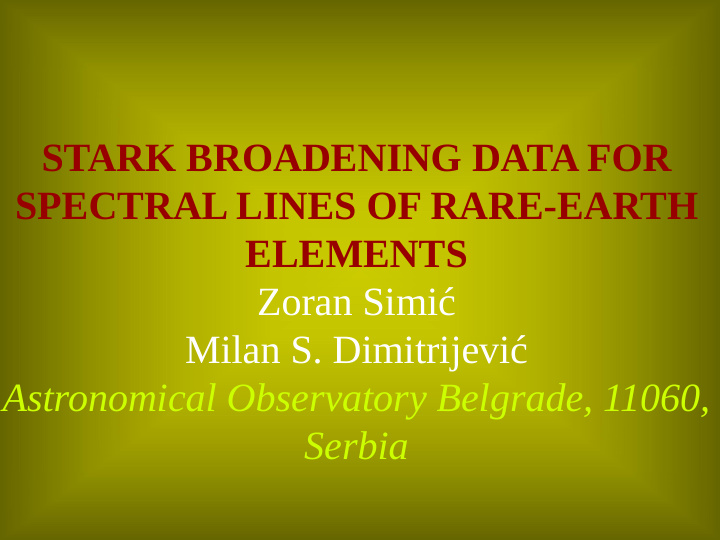



STARK BROADENING DATA FOR SPECTRAL LINES OF RARE-EARTH ELEMENTS Zoran Simić Milan S. Dimitrijević Astronomical Observatory Belgrade, 11060, Serbia
Stellar spectroscopy needs atomic and line-broadening parameters for a very extensive list of line transitions for various elements in neutral and ionized states. With the development of space-born observational techniques data on trace elements become more and more important for astrophysical problems as stellar plasma analysis and modelling, stellar opacity calculations and, interpretation and numerical synthesis of stellar spectra.
GHRS-SPECTRA OF χ LUPI
High-resolution spectra allow us to study different broadening effects using well-resolved line profiles. Stark broadening is the most important pressure broadening mechanism for A type stars and especially for white dwarfs. Neglecting this mechanism may therefore introduce significant errors into abundance determinations and spectra modellisation.
HR graph
Shape of spectral line - laboratory plasma: • NATURE • DOPPLER • PRESSURE In stellar plasma: turbulence, rotation and magnetic field
SEMICLASSICAL THEORY (Sahal-Bréchot, 1969ab)
ab initio It is possible also to perform calculations ab initio, using atomic energy levels and oscillator strengths calculated together with the Stark broadening parameters (Nessib et al., 2004).
MODIFIED SEMIEMPIRICAL THEORY (Dimitrijević & Konjević, 1980, Dimitrijević & Kršljanin, 1986).
The investigations of the influence of Stark broadening in stellar spectra started in Belgrade in 1988, when the influence of this broadening mechanism was analyzed for a typical late B type stellar atmosphere with Teff = 13 000 K and log g = 4,2 (Lanz et al., 1988).
In a number of papers, the influence of Stark broadening on Au II (Popovic et al., 1999b), Co III (Tankosic et al., 2003), Ge I (Dimi- trijevic et al., 2003a), Ga I (Dimitrijevic et al., 2004) and Cd I (Simic et al., 2005) on spectral lines in chemically peculiar A type stellar atmospheres was investigated and for each spectrum investigated atmospheric layers are found where the contribution of this broad- ening mechanism is dominant or could not be neglected. As a model for the atmosphere of an A type chemically peculiar star, a model with stellar parameters close to those of χ Lupi HgMn star of Ap type was used. Such investigations were also performed for DA and DB white dwarf atmospheres (Popovic et al., 1999b; Tank- osic et al., 2003) and it was found that for such stars Stark broad- ening is dominant in practically all relevant atmospheric layers.
Stark broadening of rare earth ions (La II, La III, Eu II and Eu III) was considered in chemically peculiar Ap stars by Popovic et al. (1999a) and found that its neglect introduces errors in equivalent width synthesis and corresponding abundance determination. Also, the influence of Stark broadening on the so called ‘‘zirconium conflict”, namely the difference in abundances obtained from weak Zr II optical lines and strong Zr III lines (detected in UV) in the spectrum of HgMn star v Lupi, was considered (Popovic et al., 2001a).
Rare Earth elements: Sc, Y, La, Eu, Nb, Lu Z. Simić, M. S. Dimitrijević
List of the ions for which we are going to to calculate the electron impact broadening parameters (Popović and Dimitrijević, 1998)
Tabela I, (Gayazov et al. 1998), prelazi su odredjeni za en. nivoa ciji je doprinos u termu 80% i vise, pomocu PDP. td(A)i ----------------------------- 5p (3F) 4G5/2 - 5d (3F) 4F3/2 priprema01 5p (3F) 4G5/2 - 5d (3F) 4F5/2 priprema02 5p (3F) 4G5/2 - 5d (3F) 4F7/2 priprema03 5p (3F) 4G7/2 - 5d (3F) 4F5/2 priprema04 5p (3F) 4G7/2 - 5d (3F) 4F7/2 priprema05 5p (3F) 4G7/2 - 5d (3F) 4F9/2 priprema06 5p (3F) 4G9/2 - 5d (3F) 4F7/2 priprema07 5p (3F) 4G9/2 - 5d (3F) 4F9/2 priprema08 5p (3F) 4G11/2 - 5d (3F) 4F9/2 priprema09 5p (3F) 4G11/2 - 5d (3F) 4H13/2 priprema10 5p (3F) 4F7/2 - 5d (3F) 4D5/2 priprema11 5p (3F) 4F7/2 - 5d (3F) 4D7/2 priprema12 5p (3F) 4F7/2 - 5d (3F) 4F5/2 priprema13 5p (3F) 4F7/2 - 5d (3F) 4F7/2 priprema14 5p (3F) 4F7/2 - 5d (3F) 4F9/2 priprema15 5p (3F) 4F9/2 - 5d (3F) 4D7/2 priprema16 5p (3F) 4F9/2 - 5d (3F) 4F7/2 priprema17 5p (3F) 4F9/2 - 5d (3F) 4F9/2 priprema18 5p (3F) 4D1/2 - 5d (3F) 4D1/2 priprema19 5p (3F) 4D1/2 - 5d (3F) 4D3/2 priprema20 5p (3F) 4D1/2 - 5d (3F) 4F3/2 priprema21 -----------------------------
f i 5p (3F) 4G5/2 - 5d (3F) 4F3/2 WL1838.0 PD1.0E+17 83% 63686.35 89% 118092.75 5p (3F) 4G5/2 - 5d (3F) 4F5/2 WL1824.8 PD1.0E+17 83% 63686.35 85% 118487.90 1838.0 1824.8 10000. 0.5990D-01 0.5922D-01 20000. 0.4236D-01 0.4187D-01 50000. 0.2679D-01 0.2648D-01 100000. 0.1933D-01 0.1913D-01 200000. 0.1746D-01 0.1729D-01 300000. 0.1756D-01 0.1741D-01
Thank you for attention!
Recommend
More recommend